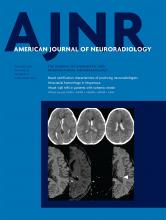Index by author
Xie, Y.
- FELLOWS' JOURNAL CLUBAdult BrainOpen AccessCerebral Venous Thrombosis: MR Black-Blood Thrombus Imaging with Enhanced Blood Signal SuppressionG. Wang, X. Yang, J. Duan, N. Zhang, M.M. Maya, Y. Xie, X. Bi, X. Ji, D. Li, Q. Yang and Z. FanAmerican Journal of Neuroradiology October 2019, 40 (10) 1725-1730; DOI: https://doi.org/10.3174/ajnr.A6212
Twenty-six participants underwent conventional imaging methods followed by 2 randomized black-blood thrombus imaging scans, with a preoptimized DANTE preparation switched on and off, respectively. The signal intensity of residual blood, thrombus, brain parenchyma, normal lumen, and noise on black-blood thrombus images were measured. The thrombus volume, SNR of residual blood, and contrast-to-noise ratio for residual blood versus normal lumen, thrombus versus residual blood, and brain parenchyma versus normal lumen were compared between the 2 black-blood thrombus imaging techniques. The new black-blood thrombus imaging technique provided higher thrombus-to-residual blood contrast-to-noise ratio, significantly lower thrombus volume, and substantially improved diagnostic specificity and agreement with conventional imaging methods.
Xue, J.
- EDITOR'S CHOICENeurointerventionOpen AccessSafety and Efficacy of Transvenous Embolization of Ruptured Brain Arteriovenous Malformations as a Last Resort: A Prospective Single-Arm StudyY. He, Y. Ding, W. Bai, T. Li, F.K. Hui, W.-J. Jiang and J. XueAmerican Journal of Neuroradiology October 2019, 40 (10) 1744-1751; DOI: https://doi.org/10.3174/ajnr.A6197
Twenty-one consecutive patients with ruptured brain AVMs who underwent transvenous embolization were prospectively followed between November 2016 and November 2018. Complete AVM nidus obliteration was shown in 16 (84%) of 19 patients. One (5%) patient with a small residual nidus after treatment showed complete obliteration at 13-month follow-up. There were 5 hemorrhages and 1 infarction; 4 patients' symptoms improved gradually. Transvenous embolization can be performed only in highly selected hemorrhagic brain AVMs with high complete obliteration rates, but it should not be considered as a first-line treatment.








